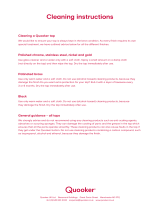
12
EN
Installation Place
Requirements
Location
Level oor : Allowable slope under the entire
appliance is 1°.
Power outlet : Must be within 1 meter of either
side of the location of the appliance.
• Do not overload the outlet with more than one
appliance.
Additional Clearance : For the wall, 10 cm:
rear/2 cm: right & left side
• Do not place or store laundry products on top
of the appliance at any time. These products
may damage the nish or controls.
WARNING
• The plug must be plugged into an appropriate
outlet that is properly installed and grounded
in accordance with all local codes and
ordinances.
Positioning
• Install the appliance on a at hard oor.
• Make sure that air circulation around the
appliance is not impeded by carpets, rugs, etc.
• Never try to correct any unevenness in the
oor with pieces of wood, cardboard or similar
materials under the appliance.
• If it is impossible to avoid positioning the
appliance next to a gas cooker or coal burning
stove, an insulation (85x60 cm) covered with
aluminum foil on the side facing the cooker
or stove must be inserted between the two
appliances.
• Do not install the appliance in rooms where
freezing temperatures may occur. Frozen
hoses may burst under pressure. The reliability
of the electronic control unit may be impaired
at temperatures below freezing point.
• Ensure that when the appliance is installed, it
is easily accessible for an engineer in the event
of a breakdown.
• With the appliance installed, adjust all four
feet using the transit bolt spanner provided to
ensure the appliance is stable, and a clearance
of approximately 5 mm is left between the
top of the appliance and the underside of any
worktop
• If the appliance is delivered in winter and
temperatures are below freezing, place the
appliance at room temperature for a few hours
before putting it into operation.
WARNING
• This equipment is not designed for maritime
use or for use in mobile installations such as
caravans, aircraft etc.
Electrical Connection
• Do not use an extension cord or double
adapter.
• Always unplug the appliance and turn off the
water supply after use.
• Connect the appliance to an earthed socket in
accordance with current wiring regulations.
• The appliance must be positioned so that the
plug is easily accessible.
• Repairs to the appliance must only be carried
out by qualied personnel. Repairs carried out
by inexperienced persons may cause injury
or serious malfunctioning. Contact your local
service centre.




















